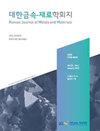高温氧化对蠕变仪中定向凝固 CM247LC 超合金表面凹坑和再结晶的影响
IF 1.4
4区 材料科学
Q4 MATERIALS SCIENCE, MULTIDISCIPLINARY
引用次数: 0
摘要
利用光学显微镜和扫描电镜对定向凝固的CM247LC蠕变试样表面高温氧化同时发生的再结晶现象进行了分析。在982oC下进行蠕变试验的试样经过热处理后,其表面在高温下发生氧化,并在高温应力作用下发生显微组织变化。发现氧化表面凹坑的最外层由Cr/Co组分的氧化物组成,下层含有Al组分的氧化物。与表面氧化层相邻的区域是无析出区(PFZ),缺少y′析出相。PFZ是由于Al成分从该区域扩散到表面氧化层,导致y'-Ni3Al作为主要Al成分耗竭而引起的。靠近PFZ的区域是y′粗化层,这是由于该区域的Cr/Co成分扩散到y相组成的PFZ中,y′相分数增加和粗化的结果。这种y'粗化和y'漂流发生在垂直于蠕变应力的方向上。在EBSD分析中,PFZ和y′粗化层为再结晶区,再结晶由包括PFZ和y′粗化层在内的单一晶粒组成。推测这种再结晶是由单向凝固的残余应力或试样表面加工的残余应力引起的。因此,DS CM247LC蠕变计的高温氧化导致了与再结晶相关的表面凹坑。本文章由计算机程序翻译,如有差异,请以英文原文为准。
Effect of High Temperature Oxidation on Surface Pit and Recrystallization of Directionally Solidified CM247LC Superalloy in Creep Gauge
This study analyzed a recrystallization phenomenon that occurred simultaneously with hightemperature oxidation on the surface of a directionally solidified CM247LC creep specimen, using optical and scanning electron microscopy. After heat treatment, the surface of the specimen subjected to the creep test at 982oC was oxidized by exposure to high temperature and underwent microstructural changes due to high temperature stress. The outermost layer of the oxidized surface pits was found to consist of an oxide of the Cr/Co component, and the lower layer contained an oxide of the Al component. The area adjacent to the surface oxide layer is a precipitated free zone (PFZ) depleted of the y’ precipitated phase. The PFZ is caused by the diffusion of the Al component from this area to the surface oxide layer, resulting in the depletion of y'-Ni3Al as the main Al component. The area adjacent to the PFZ is a y' coarsening layer, which is the result of increasing y' phase fraction and coarsening as the Cr/Co component of this region diffuses into the PFZ of the y phase composition. This y' coarsening and y' rafting occurs in the direction perpendicular to the creep stress. In the EBSD analysis, the PFZ and y' coarsened layer were observed to be recrystallized regions, with the recrystallization composed of a single grain including the PFZ and y' coarsened layer. It is presumed that this recrystallization is caused by the residual stress of one-way solidification or the residual stress of the specimen surface processing. Accordingly, high-temperature oxidation in DS CM247LC creep gauge caused surface pits associated with recrystallization.
求助全文
通过发布文献求助,成功后即可免费获取论文全文。
去求助
来源期刊

Korean Journal of Metals and Materials
MATERIALS SCIENCE, MULTIDISCIPLINARY-METALLURGY & METALLURGICAL ENGINEERING
CiteScore
1.80
自引率
58.30%
发文量
100
审稿时长
4-8 weeks
期刊介绍:
The Korean Journal of Metals and Materials is a representative Korean-language journal of the Korean Institute of Metals and Materials (KIM); it publishes domestic and foreign academic papers related to metals and materials, in abroad range of fields from metals and materials to nano-materials, biomaterials, functional materials, energy materials, and new materials, and its official ISO designation is Korean J. Met. Mater.
 求助内容:
求助内容: 应助结果提醒方式:
应助结果提醒方式:


